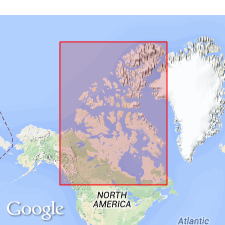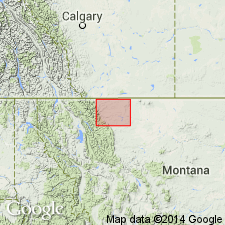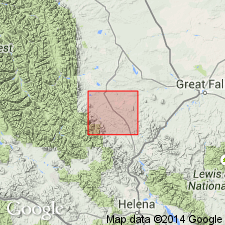
- Usage in publication:
-
- Willow Creek series
- Modifications:
-
- Named
- Dominant lithology:
-
- Clay
Summary:
Named provisionally. Source of name and type section not stated. Consists of soft red and purple clay, and gray and yellow sandstone. Thickness not stated. Has small irregular nodules in some layers. Thought to be persistent in the Laramie--a term used for Upper Cretaceous and lower Eocene beds. Overlies St. Mary River series (new) and underlies "beds of Porcupine Hills." The underlying and overlying units are also assigned to the Laramie. The outcrop of the Willow Creek follows a valley in the Porcupine Hills, across Pincher Creek and southeast to the Waterton River, and is present near the confluence with the Belly River, Alberta, CN. Fresh water mollusks, turtle fossils.
Source: GNU records (USGS DDS-6; Denver GNULEX).

- Usage in publication:
-
- Willow Creek formation*
- Modifications:
-
- Areal extent
- AAPG geologic province:
-
- Sweetgrass arch
Summary:
Name geographically extended south from Alberta, CN into Teton Co, MT on the Sweetgrass arch. Name applied to a 720 ft thick variegated clay and soft sandstone (maroon, brown, gray) that has lenticular beds of gray limestone. Fossil bones. Red soil forms on formation. Geologic map; mapped in a linear band from the CN border south to Birch Creek. Overlies St. Mary River formation. Next younger rocks are some glacial deposits. Of Eocene? age.
Source: GNU records (USGS DDS-6; Denver GNULEX).

- Usage in publication:
-
- Willow Creek Formation
- Modifications:
-
- Overview
- AAPG geologic province:
-
- Montana folded belt
Summary:
Is mapped with St. Mary River Formation in Lewis and Clark Co, MT in Montana folded belt province. Undifferentiated unit fills Swallow Canyon and Dry Creek synclines as indicated by penetrating wells. Total undifferentiated thickness is 3,700-2,000 ft. Three facies are distinguished: 1) lower lagoonal facies (1,200-800 ft thick) includes dominantly gray and calcareous shale, shaly mudstone, and muddy sandstone; locally with interbedded thin-bedded, black, nodular-weathering limestone, and thin layers of yellow-brown (10YR 6/2), shaly mudstone and muddy sandstone; 2) middle, variegated shale-mudstone facies (2,050-800 ft thick)--in Swallow Canyon syncline light olive-gray shale grades upward to interbedded olive-gray and grayish red, shaly mudstone; both are generally sandy and calcareous, and contain feldspar and biotite--in Dry Creek syncline grayish red mudstone is interbedded with light gray, non-resistant, calcareous mudstone; thin beds of pink-weathering, nodular limestone; scattered beds of muddy sandstone; and conglomerate; 3) upper, sandy facies (800+ ft thick)--sandstones first become predominant--greenish gray (5GY 6/1) sandstone beds as much as 80 ft thick, broadly lenticular and interbedded with olive-gray and reddish mudstone, which becomes thinner and fewer upward. Fossils include brackish-water pelecypods, and charophytes and ostracods in basal beds; reptile bones and pelecypods in middle facies. Age is Late Cretaceous.
Source: GNU records (USGS DDS-6; Denver GNULEX).
For more information, please contact Nancy Stamm, Geologic Names Committee Secretary.
Asterisk (*) indicates published by U.S. Geological Survey authors.
"No current usage" (†) implies that a name has been abandoned or has fallen into disuse. Former usage and, if known, replacement name given in parentheses ( ).
Slash (/) indicates name conflicts with nomenclatural guidelines (CSN, 1933; ACSN, 1961, 1970; NACSN, 1983, 2005, 2021). May be explained within brackets ([ ]).

